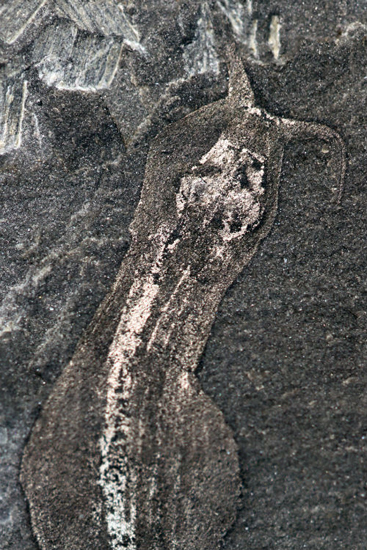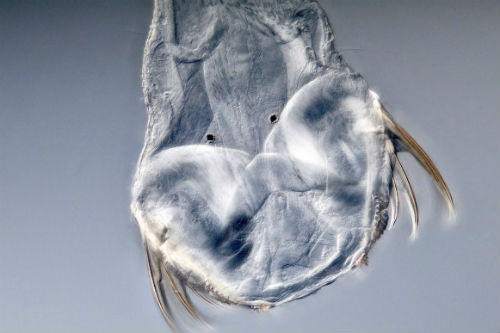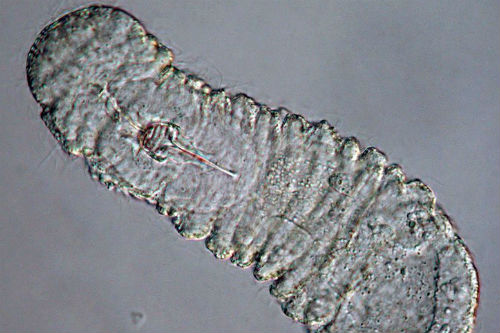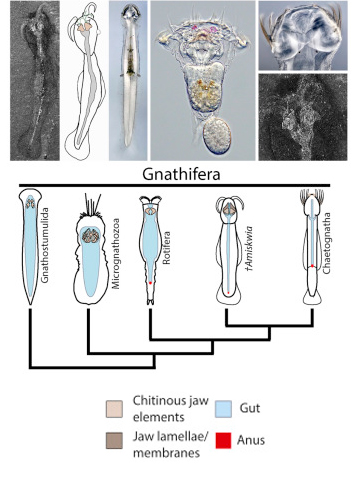Middle Cambrian Worm – Amiskwia Finds a New Home
Weird Prehistoric Worm Finally Gets Classified
Ever since Charles Doolittle Walcott, discovered the now famous Burgess Shale deposits of Cambrian-aged fossils in British Columbia, palaeontologists have marvelled at the amazing snapshot of ancient marine life the fossils represent. One of the enduring mysteries surrounding many of the preserved remains is how to classify the more than 500-million-year-old-fossil specimens. One such Burgess Shale creature, a prehistoric worm with jaws – Amiskwia sagittiformis and its equally ancient cousin A. sinica from the roughly contemporaneous Maotianshan shales of Yunnan Province, China have finally found a home on the Tree of Life.
A Fossil of Amiskwia sagittiformis (Burgess Shale)

Picture credit: Luke Alexander Parry/University of Bristol – Yale University
Analysis of Fossils from the Smithsonian Institute
Researchers from Bristol University in collaboration with a former colleague now based at the University of Yale, have identified that this soft-bodied creature is a stem lineage to arrow worms that possesses the jaw apparatus seen in microscopic gnathiferan worms. This new analysis of ancient fossils helps to link recent DNA studies on the bristle-jawed arrow worms (Chaetognatha), indicating that these worms are related to the Gnathifera, tiny, unsegmented worms with primitive jaws that like the chaetognaths, are found in marine environments.
The scientists conclude that the soft-bodied taxon Amiskwia possesses characters intermediate between chaetognaths and gnathiferans.
A Close View of the Head of an Extant Arrow Worm

Picture credit: Rafael Martin Ledo/Consejería de Educación de Cantabría
Originally Described by Walcott
Like many of the Burgess Shale animals, an original description of Amiskwia was published by Walcott (1911). Walcott made the connection with extant arrow worms (chaetognaths). These unsegmented worms are predators and they use the spines on their head for catching prey. Despite the remarkable degree of preservation of Burgess Shale specimens, fossils of Amiskwia are very rare when compared to other Burgess Shale Middle Cambrian biota. Fossils of Amiskwia sinica are also very rare in the Chinese Maotianshan shales. These types of creatures may have comprised a scarce component of the Middle Cambrian marine fauna, or perhaps, there is a fossil preservation bias.
With few fossils to study, there was widespread debate amongst scientists with regards to Walcott’s conclusions regarding the taxonomy of Amiskwia. The renowned American palaeontologist, Stephen Jay Gould (1941-2002), re-ignited the controversy by speculating that these little, soft-bodied, squished fossils represented an organism that had no modern relatives. Gould proposed that Amiskwia was an experiment in evolution that ultimately failed leaving an extinct lineage and no modern-day descendants.
Amiskwia Fossils
The problem with Walcott’s idea that Amiskwia was related to arrow worms was that scientists were unable to find evidence of any grasping spines at the anterior end of the animal in any of the fossils. Instead, many researchers proposed that Amiskwia was a representative of another group of worms the ribbon worms (Nemertea).
When Dr Jakob Vinther from the University of Bristol’s Schools of Earth Sciences and Biological Sciences and Luke Parry (Yale University), studied specimens of Amiskwia, kept at the Smithsonian Institute, they found something that had been overlooked by the previous researchers.
Dr Vinther explained:
“I coated the specimen with ammonium chloride smoke to make the relief of the fossil stand out and then I could see that in the head was a pair of robust elements.”
Amiskwia and a Set of Fossil Jaws
Interpreting these structures as a set of jaws, their resemblance led the scientists to the conclusion that there was a link between these fossils and the Gnathifera. In essence, the Amiskwia fossil material represents a sort of half-way stage between two important groups of invertebrates. Amiskwia had the jaw apparatus of a gnathiferan, but the body plan of an arrow worm.
A Microscopic Member of the Gnathifera – the gnathostomulid Rastrognathia macrostoma

Picture credit: Martin Vinther Sørensen/SNM Denmark
A Fossil Link
This study in conjunction with the recent DNA analysis, confirms that Amiskwia is the fossil link between the Gnathifera and arrow worms, the Chaetognatha. This research was originally conducted some years, ago but was not published as the paper’s conclusions lacked supporting evidence from other studies.
Dr Vinther added:
“The bizarre combination of anatomy seemed altogether alien back in 2012. Some people have proposed that there could be a relationship between arrow worms and gnathiferans based on their shared possession of a jaw apparatus, both made of a substance called chitin. However, there was little other evidence to suggest a relationship, such as evidence from phylogenetic analyses of DNA.”
Co-author of the scientific paper, Luke Parry stated:
“It altogether seemed like heresy to propose that gnathiferans and arrow worms may be related back then so we held off publishing our intriguing results out of fear of criticism from our peers. However, new DNA studies have since emerged that found arrow worms to be more and more closely affiliated to the Gnathifera in the Tree of Life. In particular, some researchers found that arrow worms share a duplication of the important Hox genes with a gnathiferan, the rotifers. We suddenly felt no more in a deadlock situation.”
Scientific Findings Published
Now the authors have published their findings in the journal Current Biology. The study follows a new phylogenetic study, which finds robust support for arrow worms forming an evolutionary group with gnathiferans.
The Inferred Phylogeny of Amiskwia and its Position in Relation to the Gnathifera and the Chaetognatha

Picture credit: Current Biology
Scientists have pieced together a little bit of the enigmatic Burgess Shale and the Chinese Maotianshan biotas and linked them to modern organisms. Amiskwia has been found a place on the Tree of Life. It is a stem lineage to arrow worms that possess the jaw apparatus seen in gnathiferan worms.
This jaw evolved into the fearsome grasping spines in living arrow worms, which play an important role in marine ecosystems.
The scientific paper: “Bilateral Jaw Elements in Amiskwia sagittiformis Bridge the Morphological Gap between Gnathiferans and Chaetognaths” by Jakob Vinther and Luke A. Parry published in Current Biology.
Everything Dinosaur acknowledges the help of a press release from the University of Bristol in the compilation of this article.
Visit the Everything Dinosaur website: Everything Dinosaur.

